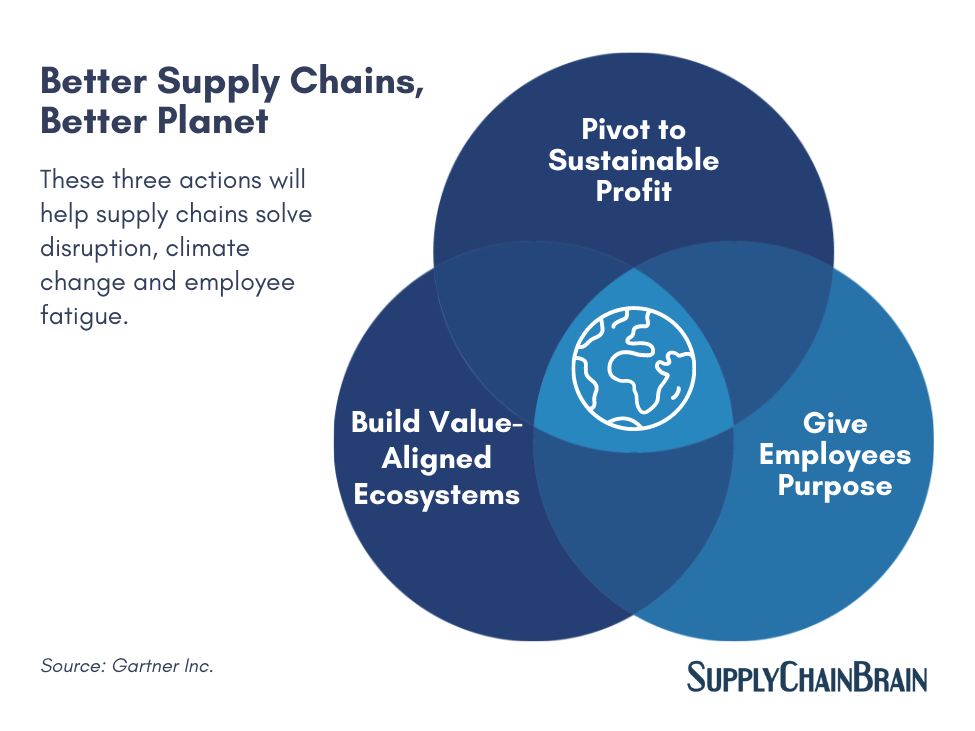
Visit Our Sponsors |
|
|
|
|
|
|
|
|
|
|
|
|
|
|
|
|
|
|
|
|
|
|
|
|
|
|
|
|
|
|
|
|
|
|
|
|
|
|
|
|
|
|
|
|
|
|
|
|
|
|
|
|
|
|
|
|
|
|
|
|
|
|
|
|
|
|
|
|

Supply chains have been in the spotlight for the past year — and not in a positive way. The struggle to supply goods to a world fractured by COVID-19 has overstretched resources and burned out employees. It’s time for chief supply chain officers to innovate their networks and commit to a sustainable and purpose-driven supply chain that is part of the solution, not the problem.
That’s the message of Gartner Inc.’s Supply Chain Symposium this week, where analysts are discussing the changes supply chain leaders must make to address pressing issues such as climate change and talent shortages without losing track of financial goals.
“We’re not the first supply chain leaders to hear scientists’ warnings, but we are the last to heed that code red for humanity — without action, the sustainability of both the planet and profits is threatened,” said Simon Bailey, senior director analyst at Gartner, during a Monday keynote address.
“The sustainability of our people is threatened as well,” said Dana Stiffler, vice president analyst. “From fields to factories, people have been pushing through to do their jobs, to deliver for their businesses and customers. In the last 12 months, 55% of employees have experienced significantly damaged health.”
To transform their supply chains, the technology research and consulting company identified three main actions that leaders can take to improve today’s most pressing issues: disruption, climate change and employee fatigue.
Pivot to Sustainable Profit
Sustainable profit means focusing on the longevity of profit and making changes that allow an organization to continue conducting business successfully into the future. Sustainable profit consists of three main parts:
“There are many examples of companies that have adopted a broader definition of profit to guide their organizations who now outperform their peers,” Stiffler said. “Stakeholder groups such as investors, customers, suppliers and employees have all responded well to the new focus on truly sustainable profit.”
Make Purpose Personal
Today’s professionals want to do meaningful work. They want to help their organizations do the right thing. However, they don’t want to be left exhausted on the way. The supply chain leader’s job is to make clear the connections between their hard work, the company’s objectives, and bigger and more impactful aims. This approach is called shared purpose.
“There’s a clear business pay-off connected to shared purpose. Gartner research sees a 26% increase in workforce health when work is personally relevant to an employee and 50% improvement in employee engagement when a company takes action on social issues,” Stiffler said.
Build Value-Aligned Ecosystems
A value-aligned ecosystem is a network of equal partners where all participants trade their capabilities through equitable value-exchange. They differ from today’s popular supplier ecosystems in that there’s no dominant entity. Gartner predicts that ecosystems will become the prime competitive entity in the future.
A Gartner survey between March and May 2021 among 400 companies in 18 industries found that today’s main drivers of ecosystem partnerships are efficiency and service. However, in three years the main drivers will be innovation and purpose.
“Leading organizations are rapidly increasing the number of ecosystem partners because they see value in being part of something bigger and leveraging novel partnerships, with new ways of working in value-aligned ecosystems,” Bailey said.
RELATED CONTENT
RELATED VIDEOS
Timely, incisive articles delivered directly to your inbox.

